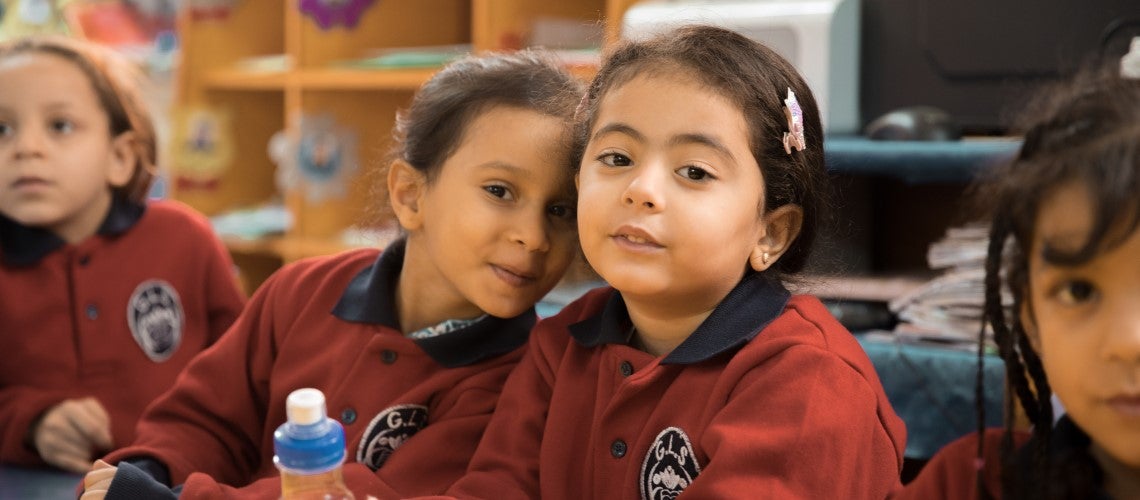 وقبل جائحة كورونا، كان العالم بصدد أزمة تعلم، وكان 53% من الأطفال في البلدان المنخفضة والمتوسطة الدخل يعانون من فقر التعلم.
وقبل جائحة كورونا، كان العالم بصدد أزمة تعلم، وكان 53% من الأطفال في البلدان المنخفضة والمتوسطة الدخل يعانون من فقر التعلم.
It is now the 2020/21 school year, but it is taking much longer than usual for 22 million students in Egypt to go Back to School. Lockdown started with a storm alert on March 13, 2020; soon after that, school closures were extended for the COVID-19 pandemic that is keeping almost 1 billion students out of school all around the world even now. Every country, Egypt included, has struggled to maintain some level of learning and progress.
This new school year, starting on October 17, 2020, comes with a reminder of Egypt’s score in Learning Poverty, a study of how much children learn at school in their country: It concluded that about 70% of children aged 10 in Egypt couldn’t read and comprehend an age-appropriate text. Egypt’s Human Capital Index (HCI), currently at 0.49, means a child born in Egypt today will be only 49% as productive when she reaches the age of 18 as she could be if she enjoyed quality education and full health. To be fair, the reforms Egypt launched in 2018 are yet to be captured in international assessments. It will take time for Egypt’s HCI to reflect their impact.
The expansion of digital learning and technological infrastructure has been a key feature of the Ministry of Education and Technical Education (MOETE)’s reform strategy. It may have cushioned the impact of school closures and strengthened the government’s response to the pandemic. Ahead of the pandemic, MOETE began rolling out a new curriculum for Kindergarten and Primary (elementary) grades 1 and 2. In the past two years, it has also made a paradigm shift in Secondary (high) School education, with the introduction of computer-based tests for grade 10 and 11, 16-17 year old students. This expansion of digital content has equipped the education system to be better prepared for the reopening of schools on October 17, 2020.
The COVID-19 crisis may have opened up opportunity to speed up some reforms, with crisis-recovery strategies forming the basis for long-term improvements in assessment, pedagogy, technology, financing, and parental involvement. Anecdotal evidence suggests that, despite some concerns, parents and students are recognizing the merits of the technology available to them, which comprises: (a) connectivity: fiberoptic in about 2,500 public secondary schools; (b) digital infrastructure: smart boards and tablets for Secondary School teachers and students; (c) student tests: computer-based testing platforms that can create different versions of the same test.
But although earlier technological infrastructure may help Egypt adapt to blended learning, the role of teachers, principals, and supervisors in channeling those resources is even more important. The pandemic has once again confirmed that the teacher is at the core.
The new normal in the 2020/21 school year brings even more changes and challenges for families: (i) a blended learning approach, combining in-person classroom learning with remote learning from home (to secure social distancing); (b) making digital and on-screen learning resources available to grades 4 to 12, though it has to be tailored for students both with and without access to digital devices and connectivity; (c) the introduction of a new digital professional development platform for training and licensing teachers; (d) empowering school principals to take on greater responsibilities and offering schools more income for infrastructure; and (e) a new, computer-based, school leaving examination focused on 21st century skills.
Globally, the pandemic has impacted less advantaged students more; students who were already at a lower point may not have had the means to use the remote resources made available in some countries. The World Bank has offered different types of support in response to the crisis, including tracking national responses and sharing them. The Bank has also made an initial assessment of potential learning loss from the pandemic and found it could reach the equivalent of about half a year’s worth (0.6 years) of schooling.
Before COVID-19, the world was already tackling a learning crisis, with 53% of children in low- and middle-income countries living in Learning Poverty. Unless drastic remedial action is taken, the effects simulated here may set back the universal goal of halving the percentage of learning poor by 2030.
In the spirit of Back to School, school supplies may differ this year, for some at least, with less need for stationery and more adjustment needed instead to blended digital learning. As the saying goes in Arabic, "it takes two hands to clap," and picking up from where we left off in the last academic year — pandemic or not— Egypt’s education reforms desperately require collective efforts from students, parents, teachers, and the community at large. In school or not, well-trained teachers are what really connect students to learning.


Join the Conversation